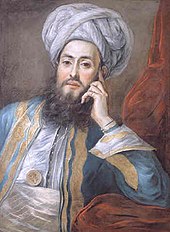| Yirmisekizzade Mehmed Said Pasha | |
|---|---|
 Mehmed Said in Stockholm as ambassador in 1733, by Georg Engelhard Schröder (now in the Pera Museum). Mehmed Said in Stockholm as ambassador in 1733, by Georg Engelhard Schröder (now in the Pera Museum). | |
| Grand Vizier of the Ottoman Empire | |
| In office 25 October 1755 – 1 April 1756 | |
| Preceded by | Köse Bahir Mustafa Pasha |
| Succeeded by | Köse Bahir Mustafa Pasha |
| Personal details | |
| Born | Unknown |
| Died | October 1761 Istanbul, Ottoman Empire |
| Nationality | Ottoman |
| Parent |
|
| Profession | Statesman, Diplomat |


Yirmisekizzade Mehmed Said Pasha (died October 1761), earlier in his life known as Mehmed Said Efendi (sometimes spelled Sahid Mehemet Effendi in France), was an Ottoman statesman and diplomat. He was Grand Vizier of the Ottoman Empire from October 25, 1755, to April 1, 1756.
He was a son of Yirmisekiz Mehmed Çelebi, ambassador of the Ottoman Empire to France in 1720–21. Mehmed Said was of Georgian descent through his father. His epithet Yirmisekizzade, meaning "son of twenty-eight" in Turkish, is a reference to his father's own epithet Yirmisekiz ("twenty-eight"), a reference to Yirmisekiz Mehmed Çelebi's membership in the 28th battalion (orta) of the Janissaries early in his life. He already accompanied his father during this first mission as his personal secretary. He is said to have enjoyed the French culture and lifestyle tremendously, and ended up speaking French fluently.
Mehmed Said was himself dispatched for an embassy in Paris in 1742, as well as another more historically significant one in Sweden in 1733 and Poland, which led to his writing a sefaretname like his father. In Sweden, he succeeded Mustapha Aga as ambassador.
He briefly served as the Shaykh al-Islam between 1749 and 1750.

See also
Notes
- ^ İsmail Hâmi Danişmend, Osmanlı Devlet Erkânı, Türkiye Yayınevi, İstanbul, 1971, p. 60.
- East encounters West by Fatma Müge Göçek p.69-70
- East encounters West by Fatma Müge Göçek p.85
- Imber, p.53
References
- Fatma Müge Göçek East encounters West: France and the Ottoman Empire in the eighteenth century Oxford University Press US, 1987 ISBN 0-19-504826-1
- Colin Imber, Keiko Kiyotaki, Rhoads Murphey Frontiers of Ottoman studies: state, province, and the West I.B.Tauris, 2005 ISBN 1-85043-664-9
| Political offices | ||
|---|---|---|
| Preceded bySilahdar Bıyıklı Ali Pasha [tr] | Grand Vizier of the Ottoman Empire 25 October 1755 – 1 April 1756 |
Succeeded byKöse Bahir Mustafa Pasha |
| Preceded bySa'deddin Pasha al-Azm | Ottoman Governor of Egypt 1757–1758 |
Succeeded byKöse Bahir Mustafa Pasha |
| State organisation of the Ottoman Empire | ||||||||||||
|---|---|---|---|---|---|---|---|---|---|---|---|---|
| Central system |
|  | ||||||||||
| Administrative divisions |
| |||||||||||
This Ottoman biographical article is a stub. You can help Misplaced Pages by expanding it. |
- 1761 deaths
- 18th-century writers from the Ottoman Empire
- 18th-century Grand Viziers of the Ottoman Empire
- 18th-century diplomats
- 18th-century Ottoman governors of Egypt
- Georgians from the Ottoman Empire
- Ambassadors of the Ottoman Empire to France
- Political people from the Ottoman Empire
- Islam in France
- Muslims from Georgia (country)
- Ambassadors of the Ottoman Empire to Sweden
- Ottoman governors of Egypt
- Shaykh al-Islāms
- Sheikh-ul-Islams of the Ottoman Empire
- Ottoman Empire people stubs
